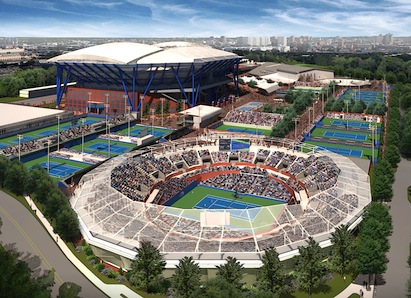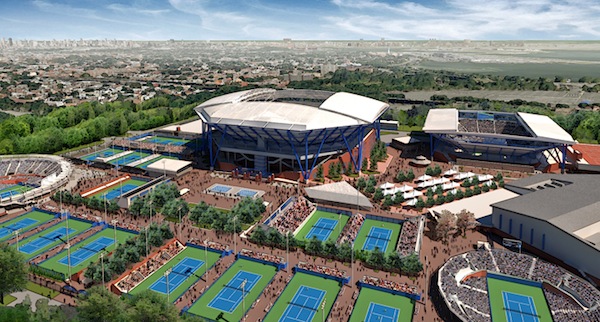FLUSHING, N.Y. – The United States Tennis Association has announced its plans for a sweeping transformation of the USTA Billie Jean King National Tennis Center that will include the construction of two new stadiums, as well as a retractable roof over Arthur Ashe Stadium. The transformation will be implemented in three phases to begin at the conclusion of the 2013 US Open, with the goal of overall completion by the 2018 US Open. The completion of the retractable roof for Arthur Ashe Stadium is scheduled for August 2017.
The cost for this historic transformation is estimated at $550 million, including the cost of the retractable roof, estimated to cost in excess of $100 million. As it has done with improvements to the National Tennis Center in the past, the USTAwill self-finance the entire cost of this transformation through a combination of bonds and USTA revenue generation. Since 1994, the USTA has invested more than $500 million in improvements to the site.
“We have been working toward a viable design for a roof on Arthur Ashe Stadium for more than a decade,” said USTAChairman of the Board and President Dave Haggerty. “Through a long and arduous process, we feel that we now have a design that meets the criteria of being architecturally sound, aesthetically pleasing, reasonably affordable, and buildable.”
In addition to the roof on Arthur Ashe Stadium, phase one of construction is scheduled to include the shifting of the existing practice courts and two tournament courts to the north. This will allow the construction of an expanded viewing area for the practice courts and the three new tournament courts. This enhanced fan experience will require the re-building of the current transportation facilities located adjacent to Arthur Ashe Stadium.
The retractable roof is being designed by ROSSETTI, the designer and architect of Arthur Ashe Stadium. The USTA has hired Hunt Construction Group to build the retractable roof structure. Hunt has a long and impressive track record of sports facility construction in New York City, including construction of the Barclays Center and Citifield. As designed, the retractable roof constructed of flexible, translucent PTFE fabric stretched over a steel frame, will be supported by eight steel columns surrounding Arthur Ashe Stadium.
Phase two of the transformation will be anchored by the construction of a new 8,000-seat Grandstand Stadium in the southwest quadrant of the Tennis Center. Simultaneously, field courts 7 through 16 will be moved south so that a larger pedestrian and fan esplanade can be created, better connecting the new Grandstand with Court 17. This southern expansion also allows the USTA to further enhance the fan experience, with a new additional food court, new merchandise locations and sponsor exhibit booths, and other fan amenities across the southern expanse of the Tennis Center.
The project’s final phase will include the construction of a new 15,000-seat Louis Armstrong Stadium. The USTAexpects final design work for Armstrong to be completed in the next 12 to 18 months. The targeted completion date of the stadium, which will be built “roof-ready,” is August 2018. Also during the third phase, the USTA will complete a series of upgrades to the East Entrance, the most trafficked entry point to the US Open.
"We have an aggressive construction agenda for the entire National Tennis Center, with a new Grandstand Court built in time for the 2015 US Open, new retractable roof over Arthur Ashe Stadium by 2017, and a new Louis Armstrong Stadium opening for the 2018 US Open,” said Gordon Smith, USTA Executive Director and Chief Operating Officer. “We recognize there are many known, and certainly many unknown, hurdles we will have to confront to meet this schedule. We are ready for the challenge and hope we can achieve it.”
As a direct result of these collective enhancements to the NTC, the facility will be able to accommodate an extra 10,000 people each day during the US Open, increasing attendance by approximately 1200,000 new visitors, and amounting to a significant economic boost to Queens, New York City and the entire metropolitan region.
The USTA is the national governing body for the sport of tennis in the U.S. and the leader in promoting and developing the growth of tennis at every level -- from local communities to the highest level of the professional game. A not-for-profit organization with more than 785,000 members, it invests 100% of its proceeds in growing the game. It owns and operates the US Open, the highest attended annual sporting event in the world, and launched the Emirates Airline US Open Series linking 10 summer tournaments to the US Open. In addition, it owns approximately 90 Pro Circuit events throughout the U.S, and selects the teams for the Davis Cup, Fed Cup, Olympic and Paralympic Games. The USTA philanthropic entity, USTA Serves, provides grants and scholarships and helps underserved youth and people with disabilities. For more information on the USTA, log on to usta.com, “like” the official Facebook page facebook.com/usta or follow @usta on Twitter.
Related Stories
| Sep 30, 2014
USGBC, Bank of America name recipients of 2014 Affordable Green Neighborhoods Grant Program
Eleven projects have been selected for the 2014 Affordable Green Neighborhoods grant program. Each will receive $31,000 and an educational package to support their pursuit of LEED for Neighborhood Development certification.
Sponsored | | Sep 30, 2014
What are you doing to win business and improve morale?? VDC Director Kris Lengieza shares ways to do both
Bluebeam's Sasha Reed sits down with Kris Lengieza, Director of Virtual Design and Construction for Stiles Corporation, to learn how he approaches change management. SPONSORED CONTENT
Sponsored | | Sep 30, 2014
How project managers can manage technology
Not long ago, the role of a construction project manager revolved around working with people: employees, vendors, consultants, designers, subcontractors and owners. Today, project managers primarily manage information. SPONSORED CONTENT
| Sep 30, 2014
With its 'stacked volumes' scheme, 3XN wins bid to design high-rise in Sydney
By dividing the 200-meter building into five separate volumes and placing atria throughout each volume, the spaces become smaller, more intimate social environments, according to the Danish architects.
| Sep 29, 2014
Living Building vs. LEED Platinum: Comparing the first costs and savings
Skanska USA's Steve Clem breaks down the costs and benefits of various ultra-green building standards and practices.
| Sep 29, 2014
10 common deficiencies in aging healthcare facilities
VOA's Douglas King pinpoints the top issues that arise during healthcare facilities assessments, including missing fire/smoke dampers, out-of-place fire alarms, and poorly constructed doorways.
| Sep 29, 2014
Snøhetta releases final plan for terraced central library in Calgary
The competition-winning New Central Library is now in the final design stages, after two years of community engagement on the part of design firms Snøhetta and DIALOG.
| Sep 25, 2014
Jean Nouvel unveils plans for National Art Museum of China
Of the design, Nouvel describes it as inspired by the simplicity of “a single brush stroke.”
Sponsored | | Sep 25, 2014
Your business doesn’t always need to change
By now, the idea that organizations must adapt to maintain both relevance and market share is so ingrained that it’s been reduced to pithy sayings. But is constant adaptation always the best policy? SPONSORED CONTENT
| Sep 25, 2014
Bjarke Ingels headed home for latest project: Aarhus Island
Aarhus Island will be a waterside development in Denmark's second-largest city. The mixed-use development will implement Ingels' signature angled look in its residential towers.




















